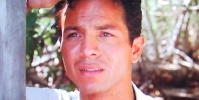|| After the Storm is one of Hemingway's best stories. Concise, based on single character, a classic lst person monologue. Guy has a fight in a tavern -- ugly, some knife work, his opponent goes down. This violence is just like the hurricane, and when the guy escapes into the sand reefs in the aftermath, it's like a hangover from a bad party. He sees some gulls gathering on the water, figures there's a wreck... and indeed it's a liner that was on its way to Havana and has gone down in the shallow water. Recognizing a salvage opportunity, he sucks in some air and dives to investigate. The imagery is sublime. Through a porthole he sees a drowned woman floating in her cabin, wearing expensive jewelry. He dives several times, attempts to break the glass and plunder the treasure. Symbolism? You bet. Sex-death matrix. The futility of it all is classic impotence, a Hemingway favorite. Guy's nose is bleeding from the underwater pressure and he knows the sharks will be around soon, so he has to abandon the salvage. Story ends with the cynical observation: "Well, the Greeks got it all. Everything. They must have come fast all right. They picked her clean. First there was the birds, then me, then the Greeks, and even the birds got more out of her than I did."

The film is nicely photographed, there's no doubt about that... and the story is extended backwards and forwards, filling in the ellipsis. The atmosphere is established by the soft orange tones and the ubiquitous wind that occurs naturally in just about every exterior scene. The hero Arno (Bratt) is anything but anonymous, although he does fit that macho drifter character so popular with Hemingway and Hollywood. And as he drifts through just about every scene in the film, you can follow the action reasonably well even if you can't figure out what some of the characters are up to. Too many secondaries? Definitely. For example, the trio of Irish buffoons... or even Mr. Big ("Ortega"), the top criminal at Pirate Caye in 1933. The aim was to establish the multi-national culture of the Bahamas at this time and certainly the director Guy Ferland and his script writer A.E. Hotchner succeed in doing this, although at the expense of clarity. Just why the hero has to be compromised never seems to be anything more than "personal" at best, the pathology of bad men in bad times.

Ferland admits in his director's commentary that he lifted a great deal from Huston's film version of Key Largo . The introduction of the gangsters into the story-line is the most obvious, as well as the Silver Slipper hotel as an eye-piece for the in-town action. This stuff works great... and to be fair to the script writer Hotchner, so does his idea of a character who starts with integrity but ends beaten by his own duplicity. The ending? There's a playfulness about it that reminds you of Body Heat, that neo-noir classic of female cunning. Is it believable? Depends whether you're convinced by the sex-power games during the final clandestine salvage operation. Possibly the indolent naturalism that's so attractive in the first part of the film gets lost in the bullshit theatrics of the underwater sequences of the last Act. The characters decline into caricature, perhaps due to the editing... or literary ambition.
Benjamin Bratt sits well in his role... and in fact is good enough to carry the film through the foggy parts of its plot. The gangster yacht [which replaces the ocean liner in Hemingway's story] is such an interesting setting you wonder why it and its decorative characters weren't developed instead of Janine and Jean-Pierre (Assante). Still, for those dedicated to the cult of Hemingway, the Frenchification of the action will seem clever and appropriate.
© LR 8/04